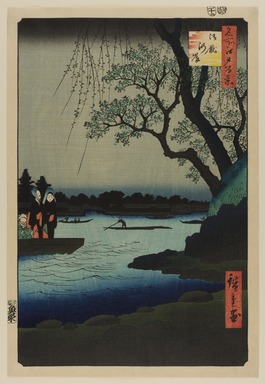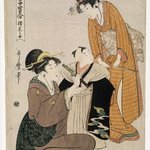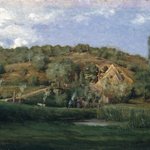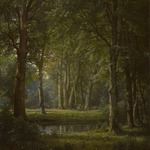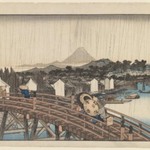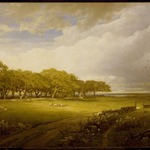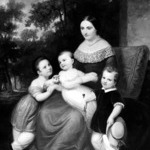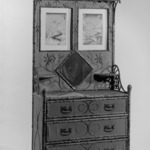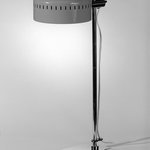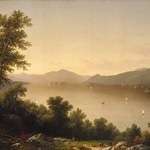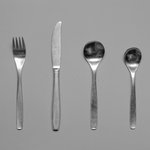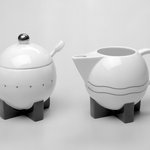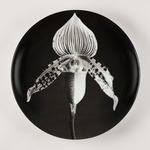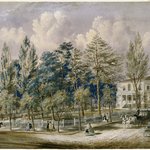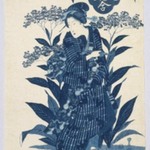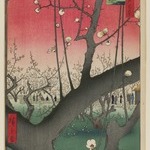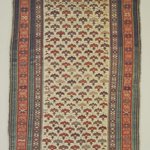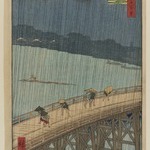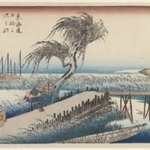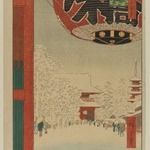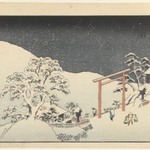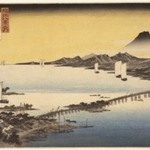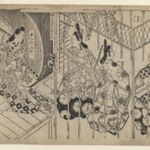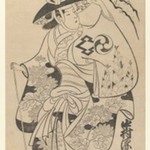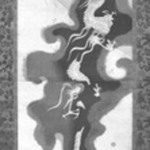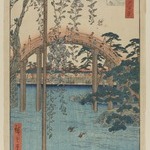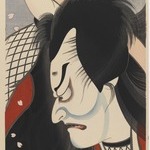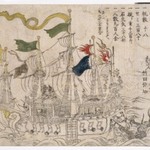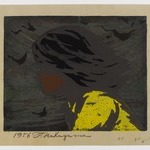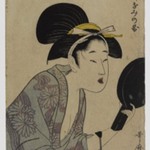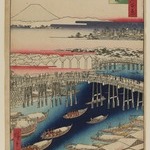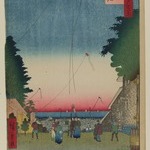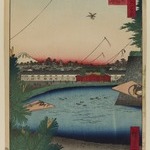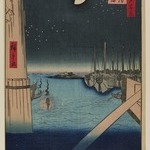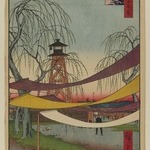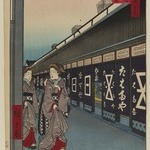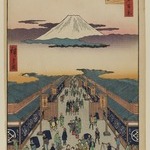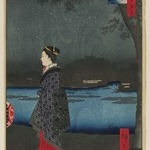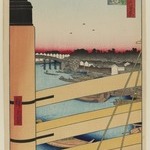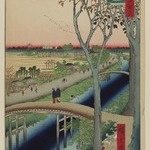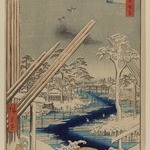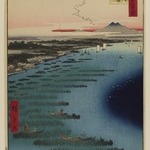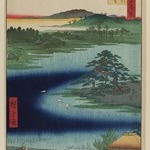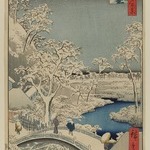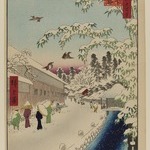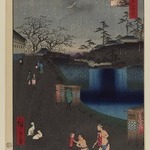Oumayagashi, No. 105 from One Hundred Famous Views of Edo
Utagawa Hiroshige
Asian Art
It is a murky winter night as the Oumayagashi ferry approaches its landing on the west bank of the Sumida River. The two figures in the bow of the ferry are yotaka, "night hawks"—the lowest class of prostitutes in Edo. This image is the closest Hiroshige ever attained to depicting the vicissitudes of the life of Edo's lower class, and he did so in a manner calculated not to offend. The faces, for example, are shown as amusing caricatures of the thick lips and pug noses for which yotaka were known. In fact, many such women were disfigured by disease, which led them to hide under the sort of thick make-up we see here. The yotaka suffered a brutal life, and their painful existence was long associated in Japanese art and literature with the cold of winter.
MEDIUM
Woodblock print
DATES
12th month of 1857
PERIOD
Edo Period, Ansei Era
DIMENSIONS
14 1/16 x 9 1/2in. (35.7 x 24.1cm)
Sheet: 14 3/16 x 9 1/4 in. (36 x 23.5 cm)
Image: 13 3/8 x 8 3/4 in. (34 x 22.2 cm)
(show scale)
MARKINGS
Publisher: Shitaya Uo Ei. Date and censor seals at top margin.
SIGNATURE
Hiroshige-ga
ACCESSION NUMBER
39.581
CREDIT LINE
Frank L. Babbott Fund
PROVENANCE
Prior to 1939, provenance not yet documented; by 1939, acquired by George Tuttle of Brookly, NY; November 24, 1939, purchased from Mr. George Tuttle by the Brooklyn Museum.
Provenance FAQ
CATALOGUE DESCRIPTION
A scene of the Oumayagashi ferry at the west bank of the Sumida River. There is an overprinting of yellow-green on the shore and at right the leaves of an evergreen oak and the grass below reflect an eerie green glow against this somber background. The two women in the bow of the ferry are yotaka ("night hawks"), the lowest class of street prostitute in Edo, on their way to work. In Hiroshige's time, yotaka had fixed places of operation, most often in lumber-storage sheds or in makeshift stalls that merchants used during the day. Their faces are shown with the thick lips and pug noses for which they were known. Many were disfigured by disease which they would hide with thick make-up. They lived in hovels along back canals in the Honjo district and catered to drunken tradesmen and violence-prone samurai underlings. Oumayagashi means "horse stable landing," after the shogunal stables that were located here until the 1690's. The Oumayagashi ferry was replaced in 1874 by Umaya Bridge, which was rebuilt in 1893 a short distance from its present location.
MUSEUM LOCATION
This item is not on view
CAPTION
Utagawa Hiroshige (Japanese, 1797–1858). Oumayagashi, No. 105 from One Hundred Famous Views of Edo, 12th month of 1857. Woodblock print, 14 1/16 x 9 1/2in. (35.7 x 24.1cm). Brooklyn Museum, Frank L. Babbott Fund, 39.581 (Photo: Brooklyn Museum, 39.581_PS20.jpg)
IMAGE
overall, 39.581_PS20.jpg. Brooklyn Museum photograph, 2023
"CUR" at the beginning of an image file name means that the image was created by a curatorial staff member. These study images may be digital point-and-shoot photographs, when we don\'t yet have high-quality studio photography, or they may be scans of older negatives, slides, or photographic prints, providing historical documentation of the object.
RIGHTS STATEMENT
No known copyright restrictions
This work may be in the public domain in the United States. Works created by United States and non-United States nationals published prior to 1923 are in the public domain, subject to the terms of any applicable treaty or agreement.
You may download and use Brooklyn Museum images of this work. Please include caption information from this page and credit the Brooklyn Museum. If you need a high resolution file, please fill out our online
application form (charges apply).
The Museum does not warrant that the use of this work will not infringe on the rights of third parties, such as artists or artists' heirs holding the rights to the work. It is your responsibility to determine and satisfy copyright or other use restrictions before copying, transmitting, or making other use of protected items beyond that allowed by "fair use," as such term is understood under the United States Copyright Act.
The Brooklyn Museum makes no representations or warranties with respect to the application or terms of any international agreement governing copyright protection in the United States for works created by foreign nationals.
For further information about copyright, we recommend resources at the
United States Library of Congress,
Cornell University,
Copyright and Cultural Institutions: Guidelines for U.S. Libraries, Archives, and Museums, and
Copyright Watch.
For more information about the Museum's rights project, including how rights types are assigned, please see our
blog posts on copyright.
If you have any information regarding this work and rights to it, please contact
copyright@brooklynmuseum.org.
RECORD COMPLETENESS
Not every record you will find here is complete. More information is available for some works than for others, and some entries have been updated more recently. Records are frequently reviewed and revised, and
we welcome any additional information you might have.
